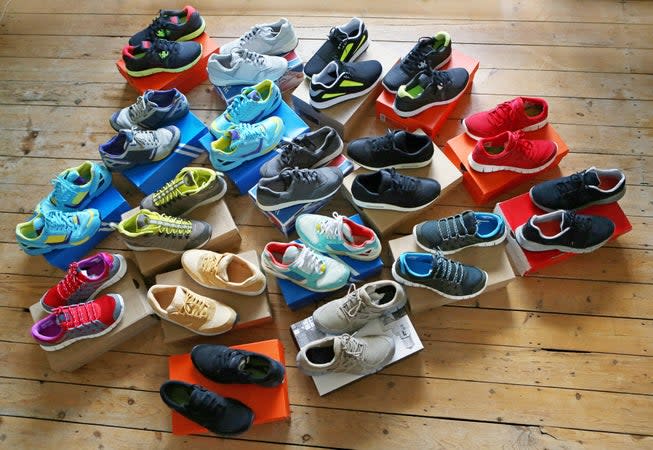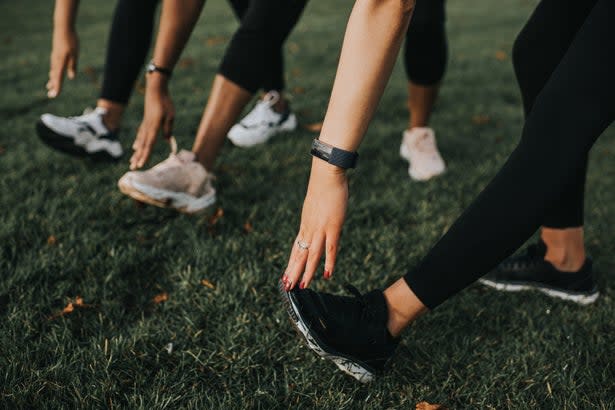What You Need to Know About Buying Running Shoes in 2022
Remember when it was practically impossible to get your hands on toilet paper and hand sanitizer? That initial pandemic shopping panic may have subsided, but the supply chain issues that have plagued the world since March 2020 could last until 2023, experts say--a fact that could be driving inflation to rise at the fastest pace since 1982. And running shoes are not immune to this phenomenon.
"[Ongoing] supply chain issues, whether it's factory closures over the summer and into early fall, transportation backlogs, and material and labor shortages, have made it so retailers--and their consumers--will truly see and feel the effects of these issues in the first quarter of 2022," says Catherine Moloznik, vice president of purchasing at Fleet Feet.

Buy Now (or Set Price Alerts)
If you're trying to snag a fresh pair of sneakers to kick off your 2022 training, now is the time to buy--or at least set up price alerts for specific shoes. "A few of our vendors have noted that the 'dark days' of inventory shortages will be felt from January through March, with inventory starting to replenish to a more 'normal' percentage starting in the second quarter," says Moloznik. "It's looking like things will start to move in a positive direction as early as April--but the production of new models will be pushed out and some vendors will not have their production calendar on the right side until 2023."
All of these issues in getting inventory into stores caused shoe prices to increase 6.5 percent in September, Footwear News reported; that's following a seven percent jump in June--the sharpest price hike in nearly 32 years.
That doesn't mean you should pay a small fortune for what you put on your feet; you just have to be a little more strategic about what shoes you buy and when you buy them. New models that launch in January are considered part of spring/summer collections. Shopping the previous autumn/winter collection (typically released six months earlier) can save you an average of $19.26, an April 2021 data analysis by RunRepeat.com found. To save an average of 10 percent, RunRepeat.com advises, wait 106 days from launch to purchase.
RELATED: Trail Shoe Preview 2022
Load Up for the Shortage
What does this all mean for you? If you're fixated on a specific type of shoes, buy two. If you run 20 miles a week and replace your shoes every 300 miles, one new pair will get you through April. But if that's when supply is estimated to start looking more normal, it might still be hard to get the pair you want. "It's a great idea to stock up," says Moloznik. "In the event that your preferred shoe model does run into shortage issues, you'll have yourself covered!"
Another reason to buy two at the same time? Alternating shoes can double the amount of time you get out of each of them. Most running shoes last between 300 and 500 miles, which equates to about four to six months for that 20-mile-per-week runner. If you're switching things up every other run, you've suddenly gotten eight months to a year. Even better: Runners who switched between two different pairs of running shoes had a 39 percent lower risk of running injury than those who almost always ran in the same shoes, according to a 2013 study in the Scandinavian Journal of Medicine & Science in Sports.
RELATED: Tips For Picking Your Next Trail Shoes
Make Your Running Shoes Last Longer
There are certain other measures you can take to prolong your sneakers' lifespan. For starters, "only wear them for what they were made for," says Amie Dworecki, head coach of Running with Life in South Bend, Indiana. Translation: If they're road shoes, wear them on the road. If they're trail shoes, stick to the dirt. "And don't wear your running shoes everywhere--like to the store, work, or running errands," she adds. "These miles count, too!"

Running repeatedly in a pair of sneakers (especially in more inclement weather) can cause odors and mold to build up over time. An easy trick to make a pair of running shoes last longer is to take the insoles out of your shoes after you run, says Dworecki. "This helps the shoe air out and breathe, and dry more easily from sweat or a rainy day. Even just making sure to untie them (before removing them) can help with this."
Whatever you do, don't toss your running shoes in the washer or dryer. The tumbling motion of the washer can affect the structure of certain foams in the midsoles, and "high heat can change the shape of the shoe and cause them to die an early death," says Dworecki. A better option is to remove the insoles, soak the shoes in a tub filled with detergent (brushing spots clean if necessary), then let them air dry.
And if you do find yourself in need of shoes in the midst of these impending "dark days" of inventory shortages, just remember to be nice to retailers.
"Being inconvenienced while shopping is never fun, but try to be as compassionate as possible," says Moloznik. "Your local run shops have been through a lot with the pandemic, labor shortages, and now supply chain issues, and everyone is doing the best they can to help you find a solution that will work best for your running needs."